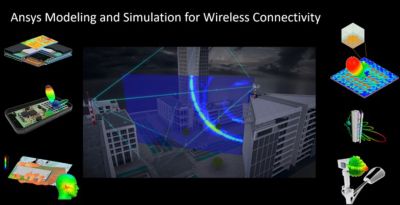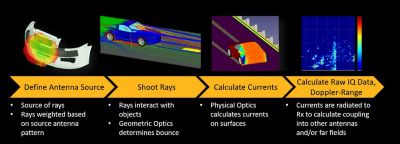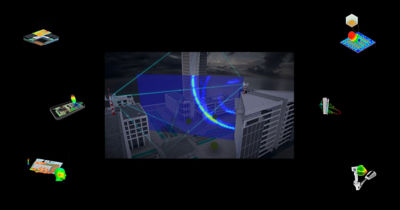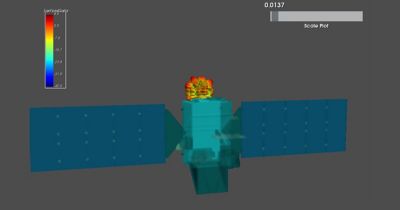As the demand for high-speed connectivity surges and the advent of 5G/6G heralds a new era in wireless communication, engineers and data scientists are faced with the daunting task of optimizing coverage in increasingly complex urban environments. To meet these challenges head-on, Ansys released Ansys Perceive EM software earlier this year.
Perceive EM software is a groundbreaking application programming interface (API) solver technology set to revolutionize radar systems and wireless communications design. With its unprecedented performance and scalability, Perceive EM software delivers high-fidelity results and enables on-demand synthetic data generation for AI/ML applications.

Modeling and simulating for wireless connectivity. The central image depicts an electromagnetic (EM) wave expanding out through a city from a small cell tower.
Emerging Challenges: Optimizing Coverage for 5G and Beyond
Urban network planning presents many challenges, from mitigating interference and achieving optimal coverage and capacity balance to negotiating blockage, multi-path, diffraction, and absorption effects. Network engineers must navigate a complex landscape of physical environments, mobile obstructions, dynamic user behavior, environmental conditions, budgetary constraints, regulatory frameworks, and more. Traditional methods, such as low-fidelity propagation models and empirical stochastic models, often fall short in accuracy. As telecommunications providers strive to deploy 5G and 6G, the need for accurate and efficient solutions has never been more pressing.
The Role of AI/ML Powered by On-demand Synthetic Data
Artificial intelligence and machine learning (AI/ML) offer promising avenues for optimizing coverage and enhancing the performance of complex networks. However, AI demands massive amounts of data for training. This data is not readily captured and labeled through measurements. To train AI, accurate synthetic data generation is a must.
“Data available from measurement methods may not be easily obtained, could have a narrow scope of coverage, or be cost-prohibitive," says Arien Sligar, senior principal product specialist at Ansys. "Simulation enables synthetic data to be generated at scale and with a high level of control over the content of the data. This makes it ideal for AI/ML training.”
Engineers can train AI models on use cases, such as predicting coverage patterns and optimizing network design by leveraging synthetic data on demand, meaning they can run computer-aided simulations to generate and use synthetic data as needed to meet AI training requirements. Synthetic data generation addresses the challenge of data scarcity, providing engineers with realistic training data for AI/ML algorithms. This approach enables iterative design optimization and empowers engineers to achieve superior network performance.
However, the effectiveness of AI algorithms relies on the quality of training data. Without accurate results representing real-world behavior and complexity, the data fed to AI models may lack the necessary quality, potentially impeding the efficiency of AI in arriving at optimal solutions.
Ansys Perceive EM: GPU-powered High-fidelity RF Channel and Radar Simulation Technology
Perceive EM software is a radio frequency (RF) propagation modeler, characterizing the coupling among many antennas distributed throughout a complex and detailed environment. It provides wireless channel models, as well as radar signals and signatures at or near real-time speeds.
Obtain High-fidelity Results
At the core of Perceive EM software lies an NVIDIA-accelerated shooting and bouncing ray (SBR) solver for rapid computation of electromagnetics, delivering highly accurate results. This remarkable technology was accomplished through innovative and patented advancements based on the SBR+ solver in Ansys HFSS software.
“This SBR technology is rooted in multi-bounce hybridization of geometrical optics and physical optics, which provides a superior level of accuracy and facility with complex geometry compared to other ray tracing solutions,” says Bob Kipp, Ansys Fellow. He further highlights that many alternatives “often rely exclusively on geometric optics with possible geometric theory of diffraction (GTD) enhancements that hinder accuracy and solution realism (i.e., choppy response trends) when deployed in realistically complex electromagnetic scattering environments.”

Shooting-bouncing ray (SBR) methodology summary
Discover Unmatched Simulation Speed
Leveraging accelerated computing powered by NVIDIA GPUs, Perceive EM software delivers significant reductions in analysis time while maintaining high-fidelity simulation results. Ansys tests show that this implementation achieved solution speedups of over 1 million times compared with its original deployment on x86-based CPUs. This means that what would have taken weeks of simulations on traditional CPUs can now be accomplished in mere minutes with the use of GPUs, effectively condensing months of simulations or years of experimentally driven designs into minutes.
This blend of high speed and precision enables modeling applications in real-world scenarios in real time. Consider a pulse-by-pulse radar system in which each transmitted and corresponding echo must be precisely analyzed in real time to detect and track targets effectively. By generating and processing the results instantly or with minimal delay, Perceive EM software enables highly detailed analysis of the radar system performance, ensuring high-resolution imaging and accurate target detection design optimization.
Similarly, in communication systems, the high-speed capabilities of Perceive EM software are vital for applications involving symbol coherence rate speeds. Symbol coherence rate refers to the ability to maintain the timing and phase integrity of each data unit during transmission. In modern communication technologies, such as 5G networks, swift data transmission and processing are essential for maintaining reliable and efficient communication. Perceive EM software seamlessly simulates communication networks at symbol coherence rate speeds, accurately capturing the complex interaction in data transmission.
Model Highly Detailed Environments
In addition to speed and accuracy, Perceive EM software handles highly detailed environments. Engineers can model radar systems and RF channels in real-world conditions and dynamic environments, including movements of objects, subscribers, and access points. This capability extends to scenarios beyond line-of-sight sensing, in which traditional methods may fall short.
For instance, consider a scenario in which a radar system is tasked with detecting objects hidden behind obstacles or around corners. The Perceive EM software advanced ray tracing algorithms can simulate the complex propagation of radio waves, including multiple reflections and scattering effects, to help accurately predict the presence and location of objects even when direct line of sight is obstructed.
Revolutionizing Radar and Wireless Communication Design
Perceive EM software represents a paradigm shift in wireless communication modeling by offering a highly performant NVIDIA GPU-powered physical optics-based SBR solver technology, deployed through a lightweight API that can seamlessly be integrated into any digital twin platform.
From optimizing coverage in congested urban environments to enhancing safety and efficiency in automotive radar and RF communications, Perceive EM software serves a wide range of applications and use cases. Imagine an AI-driven radar sensing system that automatically detects when an elderly person has fallen, or envision the precision of optimizing base station and antenna system locations for robust 6G connectivity. Consider a radar sensing application capable of generating inverse synthetic aperture radar (ISAR) or synthetic aperture radar (SAR) images — including capturing the dynamic nature of a scene — for advanced surveillance and imaging. Without simulation solutions like Perceive EM software, addressing these problems would entail expensive and time-consuming physical prototyping, chamber testing, and field trials, each prone to logistical challenges and costly delays.
Enabling Digital Twins
Perceive EM software is solely deployed as an API, giving it the versatility to run as a stand-alone scripted solution or seamlessly integrate into different workflows, whether existing or newly developed. This enables the incorporation of physics-based wireless channel and radar modeling in third-party platforms, which facilitates the creation of accurate digital twins and AI-driven applications. Ansys has showcased this new capability with the integration of Perceive EM software into the NVIDIA Aerial Omniverse Digital Twin — part of NVIDIA 6G Research Cloud, developed on the NVIDIA Omniverse platform for developing and connecting OpenUSD applications — pioneering the research and development of digital twins for 6G systems.

Radar system simulation workflow example demonstrating Perceive EM software in a sample application developed on NVIDIA Omniverse for robots and infrastructure navigation applications in a warehouse digital twin
“The NVIDIA Aerial Omniverse Digital Twin platform’s modularity facilitates the seamless integration of the Ansys Perceive EM software, bringing in cutting-edge AI/ML capabilities," says CC Chong, senior director and head of aerial product management at NVIDIA. “This empowers customers to delve into groundbreaking AI RAN 6G research and development.”
Furthermore, Perceive EM software has been integrated into Ansys STK digital engineering software, enabling Ansys RF Channel Modeler software for digital mission engineering. It has also been incorporated into Ansys AVxcelerate Sensors software for a complete solution in modeling advanced driver-assistance system (ADAS) sensors in driving simulations.
Register for our upcoming webinar “Enabling 6G Technologies” and stop by booth No. 621 at the International Microwave Symposium (IMS) to learn more about Perceive EM software.
“This empowers customers to delve into groundbreaking AI RAN 6G research and development.”
— CC Chong, Senior Director and Head of Aerial Product Management at NVIDIA
















